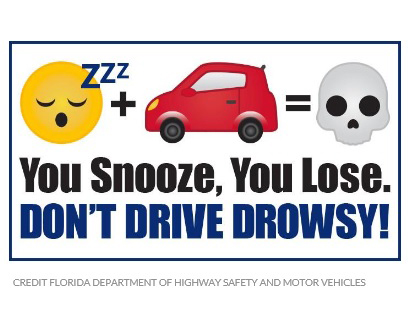Drowsy Driving May Be Just As Dangerous as Drunk Driving
September 6, 2016 | Category: Automobile Accidents | ShareIn a press release August 8, 2016, the GHSA (Governors Highway Safety Association) pointed out that nearly 83.6 million sleep-deprived Americans are driving every day. This is taking a toll; an estimated 5,000 lives were lost in drowsy-driving-related crashes in 2015.
 The NHTSA (National Highway Traffic and Safety Administration) has expanded its definition of impaired driving. It not only includes drunk, drugged or distracted driving, but also drowsy driving.
The NHTSA (National Highway Traffic and Safety Administration) has expanded its definition of impaired driving. It not only includes drunk, drugged or distracted driving, but also drowsy driving.
Who is most at risk?
Drowsydriving.org says that drivers 25 years of age and younger are involved in more than half of drowsy-driving crashes annually. Inexperienced driving, along with biological changes, school, work, social demands, and technology result in sleep-deprived teens.
More than 9.5 million people or 15 percent of the workforce, works night shifts and/or long or irregular hours, including first responders such as the police and emergency medical service personnel, doctors, nurses, and commercial motor vehicle operators, according to the NHTSA. There are also many people suffering from sleep disorders which can be undiagnosed and/or untreated. This means these sleep-deprived people may not recognize problems they may have with alertness or drowsiness when driving.
What are the symptoms of drowsy driving?
Drowsy drivers have the following symptoms according to the CDC (Centers for Disease Control):
- Yawning or blinking frequently.
- Difficulty remembering the past few miles driven.
- Missing an exit.
- Drifting from lanes.
- Hitting a rumble strip on the side of the road.
What is being done to combat the problem of drowsy driving?
There is no single countermeasure that can prevent drowsy driving. A multi-faceted approach which incorporates an array of strategies and tactics is the best approach according to GHSA:
Enforcement
Only two states, New Jersey and Arkansas, have enacted legislation that expressly addresses motorists who drive drowsy and subsequently injure or kill someone.
Currently, the Graduated Driver License (GDL) laws in 49 states and D.C. place limits on when teens can drive after dark, ranging from sundown to sunset to the less restrictive 1 a.m. to 4 a.m. The nighttime driving restriction is shown to reduce teen crashes during the restricted hours between 40 percent and 60 percent.
All states, but one, impose licensing limits on motorists with special medical conditions, but only 12 states include sleep disorders among these conditions.
Commercial motor vehicle operators must comply with federally-mandated Hours of Services (HOS) regulations.
Engineering
Engineering improvements such as rumble strips, replacing guardrails with median cable barriers and adding freeway signage are helping to make roadways safer for drowsy drivers, according to the Federal Highway Administration.
Emergency Management Service
The Insurance Institute for Highway Safety says that the automotive manufacturers and researchers have developed technologies that detect variations in driver performance and issue a drowsiness warning. These systems, which go by names of Attention Assist, Driver Alert, Driver Attention Alert, Lane Departure Warning, and EyeSight are available.
Education
WFSU in Florida reports that most states have begun implementing public awareness campaigns. The Sunshine State’s You Snooze, You Lose campaign was instituted after passage of the Ronshay Dugan Act in 2010. The legislation designates the first week of September as Drowsy Driving Prevention Week in Florida, September 5 – September 9, 2016. It also calls on the FDOT (Florida Department of Transportation) to educate law enforcement and the public about how driving drowsy is a form of impairment that is just as dangerous as driving drunk (Florida Legislature, 2011).
“Being injured in an accident can be devastating. Contact our experienced team at Spivey Law Firm, Personal Injury Attorneys, P.A. to determine your rights,” said Fort Myers Automobile Accident Attorney, Randall Spivey.
Fort Myers Automobile Accident Attorney, Randall L. Spivey is a Board Certified Trial Attorney – the highest recognition for competence bestowed by the Florida Bar and a distinction earned by just one (1%) percent of Florida attorneys. He has handled over 2,000 personal injury and wrongful death cases throughout Florida. For a free and confidential consultation to discuss your legal rights, contact the Spivey Law Firm, Personal Injury Attorneys, P.A., in Lee County at 239.337.7483 or toll free at 1.888.477.4839,or by email to Randall@SpiveyLaw.com. Visit SpiveyLaw.com for more information. You can contact Spivey Law Firm, Personal Injury Attorneys, P.A.in Charlotte County at 941.764.7748 and in Collier County 239.793.7748.

